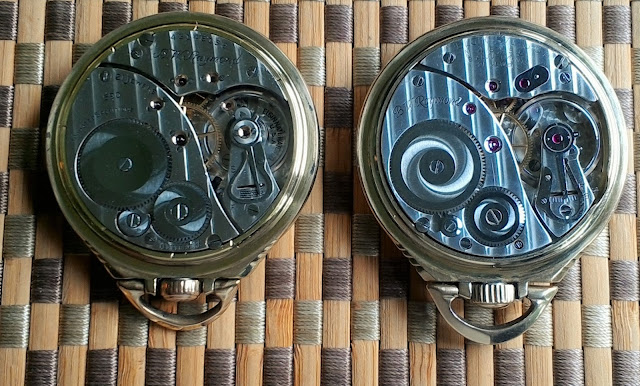On the left, you see the format used for watches to 17j (mostly - we are talking about Elgin, after all!). The Center Wheel jewel is on the Barrel Bridge, while the 3rd, 4th, and Escape Wheel jewels are on the Train Bridge. This format was introduced in 1896.
On the right is the other format, with the Center and 3rd Wheel jewels on the Barrel Bridge, with the 4th and Escape Wheel pivots on the Train Bridge. This format was introduced in 1909, and was used for watches from 17j to 23j.
Both types used set jewels in screw-down settings, and for both, the crown and stem were part of the CASE. The square shank of the case's stem entered a square hole in the Winding Sleeve.
These two formats continued to be used until 1945, including for military watches. By this time, Hamilton had introduced its 992b and 950b watches, with monometallic balances and Elinvar Extra hairsprings, negating the need for a cut, bimetallic balance to compensate for the change in eleasticity of the steel hairspring over the range of temperatures. Elgin had been using monometallic balances with hairsprings of its own alloy, called "Elginium". These first appeared in 536 series 15/0s wristwatches in 1938, and were used in the 554 series of 8/0s movements, as well as the 542 series 10s pocket watches.
It was not until 1944, however, that Elgin introduced alloy hairsprings and monometallic balances in their 16s BW Raymond models, with the model 590, seen above. The 590 was nearly identical to the earlier 478 BW Raymond which had been Elgin's main Railroad Watch for two decades. The 590 was apparently introduced because the new 571 series movements were not yet ready, and was sold in 1944 and 1945 only.
In 1946, Elgin introduced a completely redesigned series of 16s movements. For these, they used a single, new format for all grades. You can see the difference between the old and the new below. Both of these are 21j, BW Raymond movements. The older 590 is on the left, the new model 571 on the right.
The 571 replaces the screwed-down jewels in gold settings with friction-set jewels. Not as fancy, but easier to manufacture! The cap jewels are fitted into polished steel settings, which are held in place by screws from underneath the bridge or cock. If you look close to the foot of the balance cock, you may notice that the regulator screw has moved to the outside of the cock, and that the watch case has been cut to allow access.
The winding and setting works were radically changed. The picture below shows the keyless works of the pendant set models of the older version.

What you can't see is the cam and lever on the movement side. The left side is winding mode, with the clutch engaging the bevel pinion. On the right is setting mode, with the clutch engaging the minute wheel.
Below, the new design, in both pendant set (left) and lever set forms. These are based on wrist watch keyless works, with the whole stem and crown part of the movement. The pendant set form uses a standard set lever to both hold the stem in place, and allow pulling the stem up to change into setting mode. In the lever set form, the set lever is replaced with a detent, which simply holds the stem in place.
Below, both movements are in setting mode. Pulling up the stem in the pendant set pivots the set lever, which in turn pushes the clutch down into engagement with the minute wheel. In the lever set model, pulling out the setting lever causes it to push the clutch into engagement with the minute wheel.
There were 5 models sold in the 571 series:
- 571: 21j, Lever Set, Micrometric Regulator, 8 or 9 Adjustments, BW Raymond Model. This was the only Railroad Approved grade in the series.
- 572: 19j, Lever Set, Micrometric Regulator, 5 Adjustments.
- 573: 17j, Lever Set, Micrometric Regulator, 5 Adjustments.
- 574: 17j, Pendant Set, Micrometric Regulator, 5 Adjustments.
- 575: 15j, Pendant Set, Open Regulator, 4 Adjustments.
In 1950, Elgin intoduced their last 'homegrown' 16s watch movement, the 616. It is essentially the 574, with an Open Regulator.
Below, you can see the full range, from the 571 in the upper left to the 616 in the lower right.
By 1954, Elgin had stopped production of all but the 571, which continued for sometime after, though it's hard to say how long. Railroads required movements carry serial numbers to allow them to be properly recorded and tracked, so while all of Elgin's other watches lost their serial numbers in 1954 or so, the 571 was made with a block of I-prefix serial numbers set aside for them.
The 571 series make a nice little collection, and lots of parts are still readily available. The hardest to find in good condition tends to be the 575. Because it was only 15j, they often seem to have been carried till they wore out. Check the Center Wheel bushing for wear.






Elgin watches are some of my favorites. Especially the BWR's and the convertible watches
ReplyDeleteI also like the 12 size Elgin's as well. Great Blog.
Do you know where I can find an escape wheelfor 16S BW Raymond #2168?
ReplyDeleteThis comment has been removed by a blog administrator.
ReplyDelete